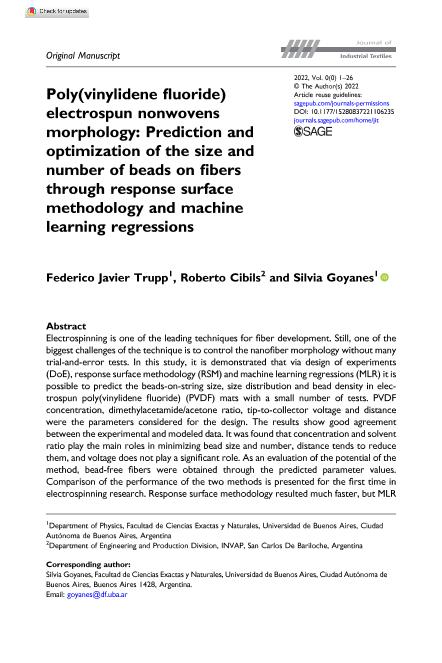Artículo
Poly(vinylidene fluoride) electrospun nonwovens morphology: Prediction and optimization of the size and number of beads on fibers through response surface methodology and machine learning regressions
Fecha de publicación:
06/2022
Editorial:
SAGE Publications
Revista:
Journal Of Industrial Textiles
ISSN:
1528-0837
Idioma:
Inglés
Tipo de recurso:
Artículo publicado
Clasificación temática:
Resumen
Electrospinning is one of the leading techniques for fiber development. Still, one of the biggest challenges of the technique is to control the nanofiber morphology without many trial-and-error tests. In this study, it is demonstrated that via design of experiments (DoE), response surface methodology (RSM) and machine learning regressions (MLR) it is possible to predict the beads-on-string size, size distribution and bead density in electrospun poly(vinylidene fluoride) (PVDF) mats with a small number of tests. PVDF concentration, dimethylacetamide/acetone ratio, tip-to-collector voltage and distance were the parameters considered for the design. The results show good agreement between the experimental and modeled data. It was found that concentration and solvent ratio play the main roles in minimizing bead size and number, distance tends to reduce them, and voltage does not play a significant role. As an evaluation of the potential of the method, bead-free fibers were obtained through the predicted parameter values. Comparison of the performance of the two methods is presented for the first time in electrospinning research. Response surface methodology resulted much faster, but MLR achieved a lower error and better generalization abilities. This approach and the availability of the MLR script used in this work may help other groups implement it in their research and find information hidden in the data while improving model prediction performance.
Archivos asociados
Licencia
Identificadores
Colecciones
Articulos(IFIBA)
Articulos de INST.DE FISICA DE BUENOS AIRES
Articulos de INST.DE FISICA DE BUENOS AIRES
Citación
Trupp, Federico Javier; Cibils, Roberto Manuel; Goyanes, Silvia Nair; Poly(vinylidene fluoride) electrospun nonwovens morphology: Prediction and optimization of the size and number of beads on fibers through response surface methodology and machine learning regressions; SAGE Publications; Journal Of Industrial Textiles; 51; 5_suppl; 6-2022; 9071S-9096S
Compartir
Altmétricas




